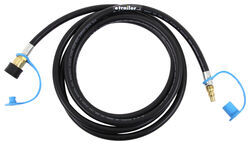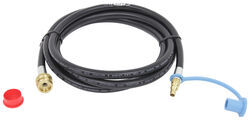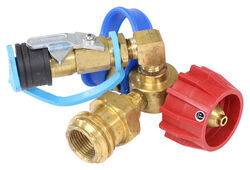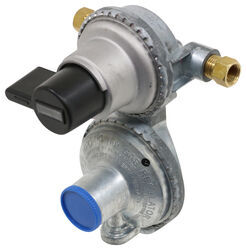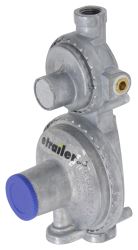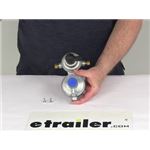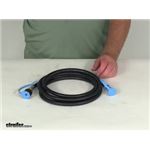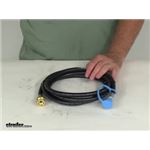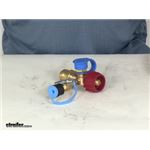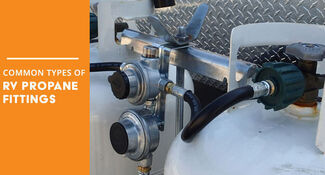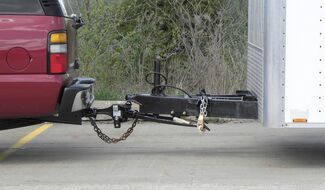
Recommended Propane Connections for Adding Second Tank and Using Both High and Low Pressure Lines
Question:
Want to add a second 20# tank with both low and HP lines Hello...I have a 2003 coleman Utah pop up. It is currently configured with one 20# tank that feeds low pressure to the inside of the camper, and HP to an outside connection. I want to add a second tank with an auto change over regulator. However, I have been told that once changeover switches tanks, I will no longer have HP LP going to the external LP line? Is there a configuration I can set up to have two tanks, still have low pressure going the inside of the camper and HP to the outside? Plus, what type of Y splitter will I need at the external connection point to run two appliances. Thank you
asked by: Rob G
Expert Reply:
We have just what you need. You can use the MB Sturgis Sturgi-Stay T-Fitting for Type 1 Valve - Quick Disconnect and Disposable Cylinder Ports # 103613-MBS to give you the high pressure connection with options for your appliance connections. The high pressure will need to be run off one tank or the other and cannot utilize the auto-changeover. You may be interested in the MB Sturgis Quick Disconnect Propane Hose for Small Appliance - Disposable Cylinder Port - 10' # 100476-120-MBS and MB Sturgis Dual Quick Disconnect Propane Hose for Small Appliance - 10' # 100395-120-MBS.
Then you can use the Camco Automatic Changeover 2-Stage Propane Regulator for Dual Propane Tanks # CAM59005 which will connect to your pigtails; one off your T-fitting and the other directly off the cylinder. For those pigtails, I recommend the MB Sturgis Propane Pigtail - Stainless Overbraid - Type 1 x 1/4" Male Inverted Flare - 1' # 100833-12.
You will have the low pressure you desire for your trailer coming out of the auto-changeover regulator. No further adapter is needed there.

Products Referenced in This Question
MB Sturgis Dual Quick Disconnect Propane Hose for Small Appliance - 10'
- Propane Fittings
- Hoses
- Adapter Hoses
- 10 Feet Long
- 1/4 Inch - Male QD
- 1/4 Inch - Female QD
- MB Sturgis
more information >
MB Sturgis Propane Adapter Hose - Model 250 Quick-Disconnect x Disposable Cylinder Port - 10'
- Propane Fittings
- Hoses
- Adapter Hoses
- 10 Feet Long
- 1/4 Inch - Male QD
- 1 Inch-20 - Male
- MB Sturgis
more information >
MB Sturgis Propane Pigtail w/ Back Check - Type 1 x 1/4" MIF - Stainless Overbraid - 1'
- Propane Fittings
- Hoses
- Pigtail Hoses
- 1 Foot Long
- Type 1 - Female
- 1/4 Inch - MIF
- MB Sturgis
more information >
MB Sturgis Sturgi-Stay T-Fitting - Type 1 Valve - Quick Disconnect and Disposable Cylinder Ports
- Propane Fittings
- Tees
- Type 1 - Female
- 1 Inch-20 - Male
- Type 1 - Male
- MB Sturgis
more information >
Camco Automatic Changeover 2-Stage Propane Regulator for Dual Propane Tanks
- Propane Fittings
- Regulators
- 1/4 Inch - FIF
- 3/8 Inch - Female NPT
- Dual Stage - Automatic Changeover
- Camco
more information >
Product Page this Question was Asked From
Camco Vertical 2-Stage Propane Regulator - 160,000 Btu/Hr
- Propane Fittings
- Regulators
- 1/4 Inch - Female NPT
- 3/8 Inch - Female NPT
- Dual Stage - Vertical
- Camco
more information >
Featured Help Information
Miscellaneous Media

Continue Researching
- Shop: Camco Automatic Changeover 2-Stage Propane Regulator for Dual Propane Tanks
- Article: How (and Where) to Connect an RV Propane Grill
- Shop: MB Sturgis Dual Quick Disconnect Propane Hose for Small Appliance - 10'
- Q&A: Size of Quick Disconnect Fitting on the Greystone # WAY94FR
- Q&A: Adapter and Hose for Connecting Small Stove to Quick Disconnect Port
- Q&A: Will the Faulkner BBQ Grill Work with the Quick Disconnect Port On a Trailer
- Q&A: Effect of Adding Propane Hose Extension to Thor RV Propane Hookup
- Q&A: What are the dimensions of this rack when off the hitch and folded for storage?
- Q&A: Will Camco Quick-Connect Fittings Work with MB Sturgis Quick-Connect Fittings
- Q&A: Can MB Sturgis Dual Quick Disconnect Propane Hose # 100395-120-MBS Work with Grill
- Video: Konig Premium Self-Tensioning Snow Tire Chains Installation - 2018 Ford Mustang
- Video: Review of GasStop Propane Fittings - Emergency Shut-Off Valve with 18" Hose - GS87FR
- Video: Hollywood Racks Hitch Bike Racks Review - 2018 Ford Mustang
- Video: MB Sturgis Propane - Hoses - 100395-120-MBS Review
- Video: MB Sturgis Dual Quick Disconnect Propane Hose Review
- Shop: Replacement Hardware Kit for Trailer Hitches
- Shop: Tekonsha Prodigy P3 Trailer Brake Controller - 1 to 4 Axles - Proportional
- Shop: Camco Propane Supply Hose - ACME Nut x Male Inverted Flare - 15" Long
- Shop: MB Sturgis Propane Adapter Hose - Type 1 x Disposable Cylinder Port - Stainless Overbraid - 12'
- Shop: Propane Hose with Back Check - Type 1 x 1/4" Male Inverted Flare - 1'
- Article: RV Propane 101: How Does My RV's Propane System Work?
- Shop: Brake Controller
- Video: Review of JR Products Propane - Hoses - 37207-30715
- Video: MB Sturgis Propane - Tees - 103537-MBS Review
- Search Results: propane regulator
- Search Results: 90885
- Article: Brake Controller 7- and 4-Way Installation Kit (ETBC7)
- Shop: Trailer Hitch
- Shop: Trailer Wiring
- Search Results: redarc



